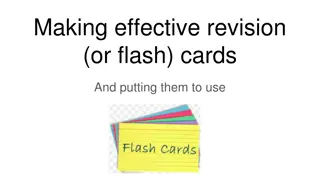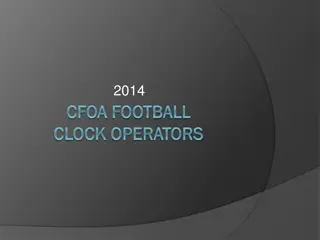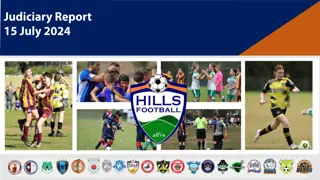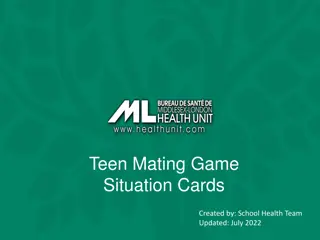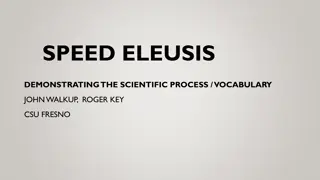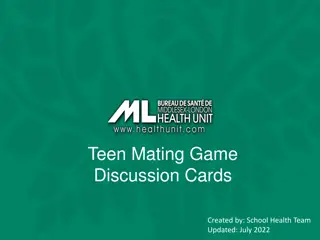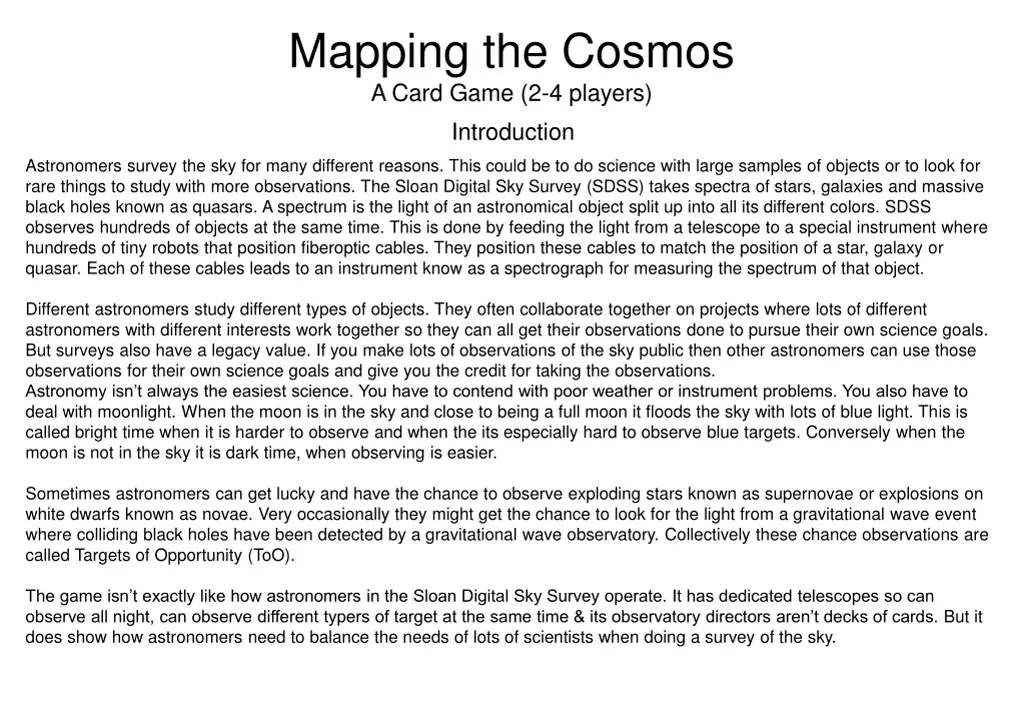
Mapping the Cosmos Card Game - Astronomers' Survey Adventure
Embark on a cosmic adventure as astronomers survey the sky in the Mapping the Cosmos Card Game. Explore different types of astronomical objects, balance observing time wisely, and strive to achieve your unique science goals. Collaborate with other players, navigate event cards, and make the most of Targets of Opportunity to succeed in this strategic game.
Download Presentation

Please find below an Image/Link to download the presentation.
The content on the website is provided AS IS for your information and personal use only. It may not be sold, licensed, or shared on other websites without obtaining consent from the author. If you encounter any issues during the download, it is possible that the publisher has removed the file from their server.
You are allowed to download the files provided on this website for personal or commercial use, subject to the condition that they are used lawfully. All files are the property of their respective owners.
The content on the website is provided AS IS for your information and personal use only. It may not be sold, licensed, or shared on other websites without obtaining consent from the author.
E N D
Presentation Transcript
Mapping the Cosmos A Card Game (2-4 players) Introduction Astronomers survey the sky for many different reasons. This could be to do science with large samples of objects or to look for rare things to study with more observations. The Sloan Digital Sky Survey (SDSS) takes spectra of stars, galaxies and massive black holes known as quasars. A spectrum is the light of an astronomical object split up into all its different colors. SDSS observes hundreds of objects at the same time. This is done by feeding the light from a telescope to a special instrument where hundreds of tiny robots that position fiberoptic cables. They position these cables to match the position of a star, galaxy or quasar. Each of these cables leads to an instrument know as a spectrograph for measuring the spectrum of that object. Different astronomers study different types of objects. They often collaborate together on projects where lots of different astronomers with different interests work together so they can all get their observations done to pursue their own science goals. But surveys also have a legacy value. If you make lots of observations of the sky public then other astronomers can use those observations for their own science goals and give you the credit for taking the observations. Astronomy isn t always the easiest science. You have to contend with poor weather or instrument problems. You also have to deal with moonlight. When the moon is in the sky and close to being a full moon it floods the sky with lots of blue light. This is called bright time when it is harder to observe and when the its especially hard to observe blue targets. Conversely when the moon is not in the sky it is dark time, when observing is easier. Sometimes astronomers can get lucky and have the chance to observe exploding stars known as supernovae or explosions on white dwarfs known as novae. Very occasionally they might get the chance to look for the light from a gravitational wave event where colliding black holes have been detected by a gravitational wave observatory. Collectively these chance observations are called Targets of Opportunity (ToO). The game isn t exactly like how astronomers in the Sloan Digital Sky Survey operate. It has dedicated telescopes so can observe all night, can observe different typers of target at the same time & its observatory directors aren t decks of cards. But it does show how astronomers need to balance the needs of lots of scientists when doing a survey of the sky.
Setup Gameplay In this game each player takes the role of an astronomer carrying out a survey of objects in the sky. At the start of the game, you will each draw one science goal card. This will say what your science goal is. Keep this card until the end of the game. Firstly, remove the legacy survey card from the science goals deck and place it face up. Shuffle the rest of the cards in the science goals deck. There are two ways to set up, quick play if you want to start quickly and normal play. Quick play: for each player put one randomly selected 1 hour card, 2 two hour cards and one each of 3,4,5 and 6 hour cards in a deck and shuffle. Remove the extra observatory cards (those marked with an *) and put all the other event cards in a deck and shuffle. Normal play: Start by building the time and event decks. Split the time deck into six piles of 1, 2, 3, 4, 5 and 6 hour cards, shuffle each. Split the event deck into weather, observatory and ToO cards, shuffle each. Remove all the extra observatory cards (those marked with an *) and don t use them in the game. Each turn (which represents a month) each player will be given observing time on three nights by the observatory director (three cards from the time deck). Place these three cards in a row in-front of you. Next, each player will also draw one event card. This could be bad weather, an interesting Target of Opportunity (ToO) or something happening at the observatory. Each player can then spend the time from each night to observe one type of object. There are four types of objects in the game: white dwarfs, nearby quasars, distant quasars and red giants. Each have slightly different observational properties. A player may only use the time on one time card for one type of object with the exception of Targets of Opportunity. Time deck: add two one hour time cards per player and two two hour time cards per player to the time deck, shuffle the deck. Event deck: for each player add one randomly selected weather card, two randomly selected observatory card and three randomly selected ToO cards. Shuffle the deck. Any player who draws a Targets of Opportunity (ToO) card can observe it by using part of the time on one night. So, for example a player with a ToO that needs one hour to observe and a two hour time card can spend one hour from this card to observe the ToO and can use the rest of the time on that card to observe one other type of object. At the end of each turn keep any target of opportunity cards you observed, discard any unobserved ToO cards. Before the start of turns 2-6 you will add more cards to the decks. Before turn 2: add two two hour time card per player to the time deck and add one randomly selected weather card per player to the event deck, shuffle both decks. Before turn 3: add two three hour time card per player to the time deck and add one randomly selected weather card per player to the event deck, shuffle both decks. Before turn 4: add two four hour time card per player to the time deck and add one randomly selected weather card per player to the event deck, shuffle both decks. Before turn 5: add two five hour time card per player to the time deck and add one randomly selected weather card per player to the event deck, shuffle both decks. Before turn 6: add two six hour time card per player to the time deck and add one randomly selected weather card per player to the event deck, shuffle both decks. At the end of every turn return all of the used time cards to the time deck. Discard all used event cards except observed Target of Opportunity cards. Shuffle both decks. The game lasts for 6 turns, with each turn representing a month. In quick play each month is equal. In normal play the game starts in the summer when the nights are short but the weather is good. As the turns progress the nights get longer but the weather gets worse. At the end of the game the legacy survey prize will be awarded to the player with the best legacy survey. You will need to observe the widest range of objects you can to win this prize.
Using Observing Time White Dwarfs blue and faint Nearby Quasars blue and bright 500 objects per hour of dark time 200 objects per hour of bright time Score 1 point per 400 white dwarfs 1000 objects per hour of dark time 400 objects per hour of bright time Score 1 point per 800 nearby quasars Distant Quasars red and faint Red Giants Red and bright 500 objects per hour of dark time 400 objects per hour of bright time Score 1 point per 500 distant quasars 1000 objects per hour of dark time 800 objects per hour of bright time Score 1 point per 1000 red giants Legacy Survey Prize Awarded to the player who has the widest range of objects observed after 6 turns. Look at the four types of objects. The lowest number of the four types of object is your legacy survey score. The player with the highest legacy survey score wins the legacy survey prize and the points it brings. Red Giants White dwarfs Nearby Quasars Distant Quasars Example: Two players have collected the following number of objects. The lowest number of the 4 types of object player 1 has is 4000, that is his legacy survey score. The lowest number of objects player 2 has is 5000, that is her legacy survey score. In this situation player 2 wins the legacy survey bonus card and the 20 points it brings. Player 1 4000 8000 6000 10000 Player 2 6000 7000 5000 7000
An Example Turn Variants to Try If you ve played the game a few times then why not try one of these variants to make things a bit different. Player 1 draws the following time and event cards Extra Observatory Cards: Use the extra observatory cards (those marked with an *) in the game Trading Time: Each turn, once all players have drawn all time and event cards, players can trade time by bartering with other players. If a player trades time on a night affected by a weather card, the effect of that weather card is applied to the time before it is traded More Science Goals: Allow players who have completed their science goal to draw a new science goal. If a player draws a new science goal and then doesn t complete it then subtract the points on the card for that science goal from that player s total at the end. Target of Opportunity Priority: ToOs are very important so you should be able to take control of the telescope to observe one. In this variant if you draw a ToO card, you may use it to take the exact amount of time listed on the card from another player. You use that amount of time from the other player to observe your ToO and they cannot use that time. All players will need to draw time and event cards for a turn/month at the same time to make this work. The full year: Play a longer version of the game in normal play by adding an extra six months. When doing this double the number of objects needed to complete each science goal and double the points for all science goals. The first six turns operate the same as the normal play rules with one exception, so not discard your event cards (with the exception of ToO cards) and shuffle them back in to the deck. At the start of turn 7, two new ToO cards per player are added to the deck. After turn 7 remove cards from the time and event deck in the Patchy Cloud Lose 50% of time on middle night 2 hour dark time 2 hours bright time 1 hour dark time Player 1 uses his 2 hours on the first night to observe white dwarfs. He has lost half of his time on the middle night to cloud so uses the remaining hour to observe red giants and then also uses the 1 hour on the last night to observe white dwarfs. He notes down 1500 white dwarfs and 800 red giants in the row for this turn on his scorecard. Player 2 draws the following time and event cards Supernova Spend 1 hour bright or dark time 2 points 2 hour dark time 1 hour dark time 2 hours bright time Player 2 uses her 2 hours on the first night to observe nearby quasars. She use the 1 hour on the middle night to observe white dwarfs. Finally she uses one hour of the time on the last night to observe her Target of Opportunity (ToO) supernova and the remaining one hour on the last night of time to observe distant quasars. As player 2 observed her ToO card she keeps it until the end of the game. She notes down 500 white dwarfs, 2000 nearby quasars and 400 distant quasars in the row for this turn on her scorecard.
SDSS is managed by the Astrophysical Research Consortium for the Participating Institutions of the SDSS Collaboration, including Caltech, the Carnegie Institution for Science, Chilean National Time Allocation Committee (CNTAC) ratified researchers, The Flatiron Institute, the Gotham Participation Group, Harvard University, Heidelberg University, The Johns Hopkins University, L Ecole polytechnique f d rale de Lausanne (EPFL), Leibniz-Institut f r Astrophysik Potsdam (AIP), Max- Planck-Institut f r Astronomie (MPIA Heidelberg), Max-Planck- Institut f r Extraterrestrische Physik (MPE), Nanjing University, National Astronomical Observatories of China (NAOC), New Mexico State University, The Ohio State University, Pennsylvania State University, Smithsonian Astrophysical Observatory, Space Telescope Science Institute (STScI), the Stellar Astrophysics Participation Group, Universidad Nacional Aut noma de M xico, University of Arizona, University of Colorado Boulder, University of Illinois at Urbana-Champaign, University of Toronto, University of Utah, University of Virginia, Yale University, and Yunnan University. Variants to Try (cont.) reverse order you added them in the first 6 months. So, at the start of turn 8 remove the 6 hour cards from the time deck and one weather card per player from the event deck. Then remove all the 5 hour cards and one weather card per player at the start of turn 9, etc. Use a second scorecard for the second six months. All observations across the twelve months towards science goals . Credits Game: Sloan Digital Sky Survey/Niall Deacon Image credits: Sloan Digital Sky Survey Illustration images: Time IC 5146; Event NGC 5257; Science Goals Stephan s Quintet, Box image Abell 2151 Icon credits: Font Awesome by Dave Gandy - fontawesome.io Thanks to the Anne-Marie Weijmans, the St Andrews galaxies group, Emily Griffith & the group at the University of Colorado, and the Haus der Astronomie BOGY interns for helping to test the game and for giving helpful feedback and suggestions for new rules. Published under a Creative Commons CC-BY-4.0 License Funding for the Sloan Digital Sky Survey V has been provided by the Alfred P. Sloan Foundation, the Heising-Simons Foundation, the National Science Foundation, and the Participating Institutions. SDSS acknowledges support and resources from the Center for High-Performance Computing at the University of Utah. SDSS telescopes are located at Apache Point Observatory, funded by the Astrophysical Research Consortium and operated by New Mexico State University, and at Las Campanas Observatory, operated by the Carnegie Institution for Science. The SDSS web site is www.sdss.org.
Teacher Notes This game presents a very simplified version of some of the trade-offs astronomers need to make when conducting surveys. Some things your students may learn playing this game: Notes on types of objects: White dwarfs are the remnants of stars that have reached the end of their hydrogen burning lives and then evolved first to giant stars and then to planetary nebulae. In the planetary nebula phase the dying star throws off its outer layers, leaving only the remaining hot dense core. This hot dense core is the white dwarf. White dwarfs cool over time at a predictable rate so can be used as probes of the history of our galaxy. Red giants are old stars that have finished burning hydrogen in their cores but haven t yet reached the point of evolving in to white dwarfs. They are bright and the different lines in their spectra can be used to estimate the abundances of different elements. Nearby and distant quasars are both types of quasars. Gas and dust falling towards supermassive black holes at the heart of distant galaxies can form a disk of material orbiting the black hole. The huge gravitational pull of these black holes can lead to these disks rotating extremely fast and the material in them becoming very hot. These huge hot disks of material are extremely bright and can outshine all of the stars in the surrounding galaxy a thousand times over. Quasars spectra are redshifted, the more distant they are the more they are redshifted. This moves some of their bright emission features from ultraviolet light, to visible light, or for the most distant quasars, to the infrared. This changes the colours of the quasars, making more distant quasars appear redder. Poor weather can affect astronomical observations Sometimes astronomical instruments have problems that may affect observations (the game exaggerates how often and severe these are). Much of science is done by large groups of scientists with different interests who work together Moonlight can affect astronomical observations, particularly when looking in blue light Luck can also be a factor Astronomers need to take lots of things into account when planning efficient observations Some notes on specific cards: the red monster was a nickname given to an instrument problem that occasionally would affect the redder part of the spectrum. It made the spectra less accurate but didn t stop the observation of red objects. A bear did once get into the kitchen at the Apache Point Observatory, nobody was harmed by the bear. Moths do sometimes get into our spectrographs as they are nice, warm places. Other observatories sometimes have surprise visitors like scorpions. Bonsai is the dog of one of the staff at Apache Point, he s very friendly to visitors.
Teacher Notes (cont.) Notes on observing time: Astronomers typically try to observe objects so that they get a good ratio of signal to noise. If the signal to noise ratio of an observation of an object is too low then noise could make measurements of the properties of that object too inaccurate to use. Normally the longer you observe for, the better your signal to noise ratio. But at some point once an object has been observed for long enough, the signal to noise ratio is high enough for the purposes the astronomer wants to use the observation for so it would be a waste of time to observe for longer. The fainter the object, the longer you would need to observe to get the required signal to noise ratio. The brightness of an astronomical object is a combination of the object s intrinsic brightness and how far away that object is. The game over-simplifies brightness into objects being either bright or faint The moon affects observations. When the moon is close to full and in the sky it emits a lot of blue light. This means that if you are trying to study objects where their properties in blue light is important, the observations will be made worse by the moon being in the sky. Hence astronomers prefer to observe faint, bluer objects in dark time when the moon is not in the sky as opposed to bright time when it is. Here are several ways you could use this game in a wider lesson: Ask your students to research the different types of objects used in this game and why astronomers study their spectra. Ask the students about the usage of observing time. Why do they think fewer faint objects are observed per hour? Discuss with students how they would decide on how to allocate telescope resources. See if your students get something like the common model of writing proposals for observations and then a committee evaluating these proposals or if they have a different idea. Give students or groups of students one science goal card each and ask them to come up with arguments as to why this science goal is important. This will involve background research. Download and print copies of this game More SDSS educational activities voyages.sdss.org From Zenodo record: 15526772 From SDSS
Time Time Time Time Time Time Time Time
1 hour Dark Time 1 hour Dark Time 1 hour Dark Time 1 hour Dark Time 1 hour Dark Time 1 hour Dark Time 1 hour Bright Time 1 hour Bright Time
Time Time Time Time Time Time Time Time
2 hours Dark Time 2 hours Dark Time 2 hours Dark Time 2 hours Dark Time 2 hours Dark Time 2 hours Dark Time 2 hours Dark Time 2 hours Dark Time
Time Time Time Time Time Time Time Time
2 hours Bright Time 2 hours Bright Time 2 hours Bright Time 2 hours Bright Time 2 hours Bright Time 2 hours Bright Time 2 hours Dark Time 2 hours Dark Time
Time Time Time Time Time Time Time Time
3 hours Dark Time 3 hours Dark Time 3 hours Bright Time 3 hours Bright Time 4 hours Dark Time 4 hours Dark Time 4 hours Bright Time 4 hours Bright Time
Time Time Time Time Time Time Time Time
3 hours Dark time 3 hours Dark time 3 hours Dark time 3 hours Dark time 4 hours Dark time 4 hours Dark time 4 hours Dark time 4 hours Bright time
Time Time Time Time Time Time Time Time
5 hours Dark Time 5 hours Dark Time 5 hours Bright Time 5 hours Bright Time 6 hours Dark Time 6 hours Dark Time 6 hours Bright Time 6 hours Bright Time
Time Time Time Time Time Time Time Time
5 hours Dark Time 5 hours Dark Time 5 hours Dark Time 5 hours Dark Time 6 hours Dark Time 6 hours Dark Time 6 hours Dark Time 6 hours Bright Time
Event Event Event Event Event Event Event Event
ToO ToO ToO ToO Supernova Spend 1 hour of bright or dark time to receive 2 points If you observe this card keep it until the end of the game. Otherwise discard it Supernova Spend 1 hour of bright or dark time to receive 2 points If you observe this card keep it until the end of the game. Otherwise discard it Supernova Spend 1 hour of bright or dark time to receive 2 points If you observe this card keep it until the end of the game. Otherwise discard it Supernova Spend 1 hour of bright or dark time to receive 2 points If you observe this card keep it until the end of the game. Otherwise discard it ToO ToO ToO ToO Supernova Spend 1 hour of bright or dark time to receive 2 points If you observe this card keep it until the end of the game. Otherwise discard it Supernova Spend 1 hour of bright or dark time to receive 2 points If you observe this card keep it until the end of the game. Otherwise discard it Supernova Spend 1 hour of bright or dark time to receive 2 points If you observe this card keep it until the end of the game. Otherwise discard it Supernova Spend 1 hour of bright or dark time to receive 2 points If you observe this card keep it until the end of the game. Otherwise discard it
Event Event Event Event Event Event Event Event
ToO ToO ToO ToO Peculiar Supernova Spend 2 hour of bright or dark time to receive 4 points If you observe this card keep it until the end of the game. Otherwise discard it Peculiar Supernova Spend 2 hour of bright or dark time to receive 4 points If you observe this card keep it until the end of the game. Otherwise discard it Peculiar Supernova Spend 2 hour of bright or dark time to receive 4 points If you observe this card keep it until the end of the game. Otherwise discard it Peculiar Supernova Spend 2 hour of bright or dark time to receive 4 points If you observe this card keep it until the end of the game. Otherwise discard it ToO ToO ToO ToO Galactic Nova Spend 2 hour of bright or dark time to receive 5 points If you observe this card keep it until the end of the game. Otherwise discard it Galactic Nova Spend 2 hour of bright or dark time to receive 5 points If you observe this card keep it until the end of the game. Otherwise discard it Galactic Nova Spend 2 hour of bright or dark time to receive 5 points If you observe this card keep it until the end of the game. Otherwise discard it Gravitational Wave Event Spend 3 hours of dark time to receive 15 points If you observe this card keep it until the end of the game. Otherwise discard it
Event Event Event Event Event Event Event Event
Observatory Observatory Observatory Observatory Great Conditions Observatory Dog Observatory Dog Robot Error Some of the robots that position the fibers on your spectrograph have failed. Lose 1/3 of the objects you observe on all nights this month (round your remaining objects up to the nearest 100 objects) An unusually calm atmosphere and clear skies mean that your observations are even more efficient than usual. Add 20% to all the numbers of objects you observe this month. Round up to the nearest hundred for each type of object. Bonsai, the observatory dog, comes to visit. This doesn t change your observations, but you feel better petting the good boy. Bonsai, the observatory dog, comes to visit. This doesn t change your observations, but you feel better petting the good boy. Observatory Observatory Observatory Observatory Moth Infestation Observatory Dog BEAR!!!!! Red Monster A hungry bear is ransacking the observatory kitchen, evacuate now! Lose all of your observing time on the middle night A strange instrument error known as the red monster has affected your red spectrograph. You may not observe red objects on the right- most night. Your blue spectrograph is infested with moths. You may not observe any blue objects on the left-most night Bonsai, the observatory dog, comes to visit. This doesn t change your observations, but you feel better petting the good boy.
Event Event Event Event Event Event Event Event
Weather Weather Weather Weather Thick Cloud Thick Cloud Thick Cloud Thick Cloud Lose all of your observing time on the left-most night Lose all of your observing time on the right-most night Lose all of your observing time on the right-most night Lose all of your observing time on the left-most night Weather Weather Weather Weather Thick Cloud Thick Cloud Constant Cloud Constant Cloud Lose all of your observing time on the middle night Lose all of your observing time on the middle night Lose all of your observing time this month Lose all of your observing time this month
Event Event Event Event Event Event Event Event
Weather Weather Weather Weather Patchy Cloud Patchy Cloud Patchy Cloud Patchy Cloud Lose 50% of your observing time on the left-most night (round your remaining observing time up to the nearest hour) Lose 50% of your observing time on the left-most night (round your remaining observing time up to the nearest hour) Lose 50% of your observing time on the left-most night (round your remaining observing time up to the nearest hour) Lose 50% of your observing time on the left-most night (round your remaining observing time up to the nearest hour) Weather Weather Weather Weather Patchy Cloud Patchy Cloud Patchy Cloud Patchy Cloud Lose 50% of your observing time on the middle night (round your remaining observing time up to the nearest hour) Lose 50% of your observing time on the middle night (round your remaining observing time up to the nearest hour) Lose 50% of your observing time on the middle night (round your remaining observing time up to the nearest hour) Lose 50% of your observing time on the middle night (round your remaining observing time up to the nearest hour)
Event Event Event Event Event Event Event Event
Weather Weather Weather Weather Patchy Cloud Patchy Cloud Patchy Cloud Patchy Cloud Lose 50% of your observing time on the left-most night (round your remaining observing time up to the nearest hour) Lose 50% of your observing time on the left-most night (round your remaining observing time up to the nearest hour) Lose 50% of your observing time on the left-most night (round your remaining observing time up to the nearest hour) Lose 50% of your observing time on the left-most night (round your remaining observing time up to the nearest hour) Weather Weather Weather Weather Patchy Cloud Patchy Cloud Patchy Cloud Patchy Cloud Lose 50% of your observing time on the left-most night (round your remaining observing time up to the nearest hour) Lose 50% of your observing time on the middle night (round your remaining observing time up to the nearest hour) Lose 50% of your observing time on the middle night (round your remaining observing time up to the nearest hour) Lose 50% of your observing time on the middle night (round your remaining observing time up to the nearest hour)
Event Event Event Event
Observatory* Observatory* Nearby Quasars bright and blue White Dwarfs faint and blue Hard Drive Error The huge churning disks of hot gas orbiting black holes are the brightest objects in the universe. Snow Storm The glowing remnants of dead stars can be used to trace the history of our galaxy. The hard drive you stored some of your data on has crashed. Lose 50% of the objects you observed in the previous month. If you draw this in month number one ignore this card A huge snow storm is approaching the observatory, everyone must evacuate. All players lose all their time from all of their nights this month. Observing Observing 1 hour dark time 500 1 hour bright time 200 1 hour dark time 1000 1 hour bright time 400 Scoring 1 point per 400 Scoring 1 point per 800 Observatory* Observatory* Distant Quasars faint and red Red Giants bright and red Great Conditions Classification Error The algorithm you used to select objects in the previous month had an error in it and you observed the wrong types of object. Switch the numbers of objects you observed last month as follows The hot disks around black holes shine like beacons in the furthest reaches of the cosmos. These bright stars at the end of their lives can be used to map the structure and chemical history of the galaxy. An unusually calm atmosphere and clear skies mean that your observations are even more efficient than usual. Add 20% to all the numbers of objects you observe this month. Round up to the nearest hundred for each type of object. Observing Observing 1 hour dark time 500 1 hour bright time 400 1 hour dark time 1000 1 hour bright time 800 white dwarfs nearby quasars nearby quasars white dwarfs distant quasars red giants red giants distant quasars Scoring 1 point per 500 Scoring 1 point per 1000 If you draw this in month number one ignore this card
Science Goal Science Goal Science Goal Science Goal Science Goal Science Goal Science Goal Science Goal
Cosmological Mapper Observe at least 10,000 nearby quasars and at least 5,000 distant quasars 15 points Nearby Universe Mapper Observe at least 15,000 nearby quasars 10 points Distant Universe Mapper Observe at least 9,000 distant quasars 10 points Quick Reactions Observe at least 2 targets of opportunity 10 points All Galactic Mapper Observe at least 10,000 red giants and 5,000 white dwarfs 15 points Galactic Archeologist Observe at least 7,500 white dwarfs 10 points Galactic Structure Mapper Observe at least 18,000 red giants 10 points Legacy Survey Observe the broadest range of objects. 20 points











